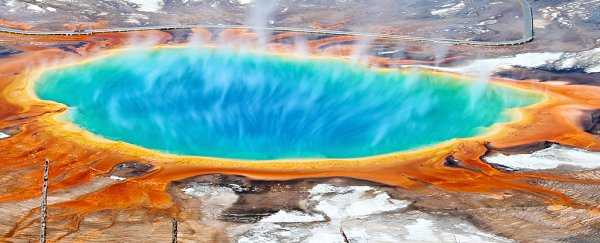The Yellowstone supervolcano is a region of significant geological activity beneath Yellowstone National Park, in the northwestern corner of the US.
On the surface, the activity can be seen as heated springs and geysers, and felt as occasional earth tremors. But it's the activity of a migrating 'hot spot' below which is ultimately responsible for periodic eruptions that have dramatically reshaped the landscape over millions of years.
There are two competing models explaining the cause of this heat engine; one involves friction from rubbing tectonic plates in Earth's crust; the other, a plume of churning magma deep inside the mantle. Either way, the hot spot's impact stretches far, far back in geological time.
For roughly 17 million years, North America's tectonic plate has gradually crept across the churning heat, scarring virtually the entire western edge of the continent, perhaps as far as what is today southwest Yukon in Canada.
During the past 2.1 million years, several major volcanic events have caused Yellowstone's landscape to sink into a vast 55 by 72 kilometre (34 by 44 mile) caldera, or depression.
The last major eruption in Yellowstone took place a little more than 630,000 years ago. With a previous eruption occurring a little more than 600,000 years before that.
The timing suggests we are overdue for another sometime 'soon', but scientists say that's probably not the case.
In reality, there is no simple way to forecast volcanic eruptions, with many factors potentially influencing the rate, power and timing of geological activity.
A recent study, in fact, suggests activity at the magma-fuelled hotspot is actually on the wane and becoming more sporadic.
Why is Yellowstone's volcano 'super'?
Much like a super moon, supervolcanoes don't carry great weight as a scientific expression. There are several competing origin stories for this sensationalist term, but according to volcanologist Erik Klemetti in writing for Wired it comes from a 1925 travelogue called Conquering the World, by "inveterate wanderer" Helen Bridgeman. Since then, documentaries have promoted the term further, especially in connection with Yellowstone.
What had initially referred to conglomerates of volcanoes now describes a volcano with a history of mammoth-sized explosions. Specifically, eruptions that reach a max score on the Volcano Explosivity Index (VEI), which is comparable to the Richter Magnitude scale for earthquakes.
In this case, the VEI ranks volcanic events based on the amount of fragmental material, known as tephra, which they eject. Starting at 0, anything ranked 1 or above sends at least 100,000 cubic meters of rocks and particles flying.
Each level is 10 times more powerful than the previous, so an index score of 8 describes eruptions that blast out more than 1,000 cubic kilometres (240 cubic miles) of crust.
Yellowstone has matched and even exceeded this power at least twice in the past.
Were it to do so again, most direct damage from explosive forces and lava flows would be restricted to a portion of the national park.
But surrounding states including Wyoming, Montana, Idaho, and Colorado might be hit by a thick blanket of ash that would destroy crops, crush roofs, electrical equipment and other delicate structures, and directly risk human health.
Going on past eruptions of similar magnitudes, the supervolcano's ash cloud might also lead to significant global cooling for a few years, affecting local climates in ways that could also reduce yields from agriculture.
Fingers crossed Yellowstone stays quiet for a few more millennia.
All topic-based articles are determined by fact checkers to be correct and relevant at the time of publishing. Text and images may be altered, removed, or added to as an editorial decision to keep information current.
